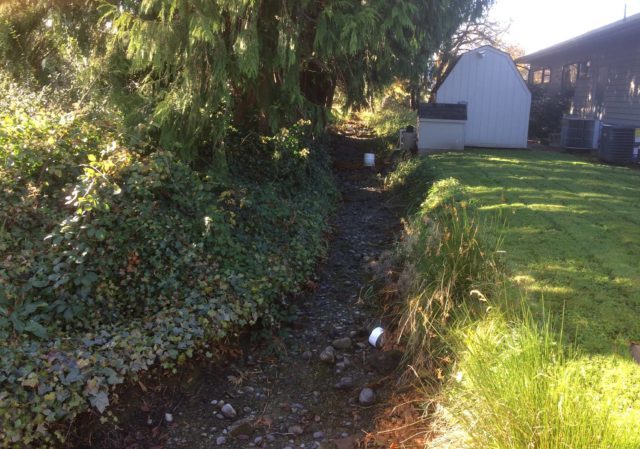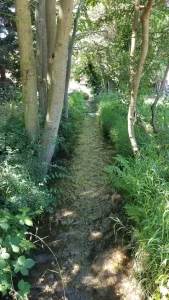
By Pepper Fisher
SEQUIM – On May 1, 1896, Sequim farm families celebrated their completion of the first hand dug irrigation ditch carrying Dungeness River water to the dry Sequim Prairie. The farmers who organized the Sequim Prairie Ditch Company in 1895 were later joined by some 20 other ditch companies, who constructed a maze of canals throughout the Dungeness Valley.
Most of the original canal has remained an open ditch for almost 130 years, and still runs through private properties along easements with 10-foot buffers on either side. The ditch is managed by the non-profit corporation Sequim Prairie-Tri Irrigation Association (SPTIA), with assistance from Clallam Conservation District (CCD), and the Washington Department of Fish and Wildlife.
Working together, those three partners have decided that it’s time to pipe 11,500 feet of open ditch and cover it all over as a way of saving untold gallons of water from evaporation and seepage. They say doing so will increase the streamflow of the Dungeness River, which will help protect salmon, steelhead and other fish listed in the Endangered Species Act.
But the decision to pipe the ditch was made without the consent of the separate landowners whose property it runs through, and many of them are trying to stop it. They see the plan as one that will bury Sequim’s most important and beloved historical symbol, and the namesake of the Sequim Irrigation Festival, the longest-running festival in the state of Washington. They also say the move will destroy what has become a valued wildlife corridor along some of its sections.
Virginia Shogren is an attorney and one of the landowners, and therefore a shareholder, of the SPTIA, also known as The Ditch Company. She not only objects to piping the historic ditch, but to the way it was announced.
“And without contacting us or getting any of our consent, they applied for federal funding with the Bureau of Reclamation, millions of dollars, to put in piping in our yards, basically, on our property, and never contacted us. The only way we found out was by going to the annual meeting for the Ditch Company this year, where they first announced it as if it were a done deal. And I specifically asked, ‘What was the process for shareholder approval?’ And I was told there will be none.
In April, Shogren sent them a cease and desist letter. She claims, in part, that the Ditch Company is operating outside of its own bylaws, which she says exists only to provide water to the shareholders and to maintain an open ditch, not a pipeline.
The Ditch Company’s lawyer, Thomas Pors, refused the demand, saying the Ditch Company’s primary purpose is to deliver irrigation water to shareholders, not to maintain an open ditch for “historical” or other purposes. He also claims the shareholders’ rights do not include historic preservation or the continuation of waste, inefficiency, or the destruction of threatened and endangered species or their habitat. A lawsuit could be imminent.
The situation is playing out as another story of difficult decisions having to be made in a changing world. Dozens of irrigation ditches in the Dungeness Valley have been piped in the last 20 years or so, and the rationale behind it is hard to argue against. The snow in the Olympic Mountains is melting earlier than it used to, summers are getting hotter and longer, and stream flows are dropping as a result.
Of course, we’re not talking about any old ditch. We’re talking about the Sequim Prairie main canal, and it’s certainly understandable that it has a special place in the hearts of its caretakers.
“Yeah, if you talk to other landowners you’ll find probably a similar answer, which is, one of the reasons why we chose this particular lot to purchase is because it is part of Sequim’s history. And the ditch adds to not only a wildlife corridor, but beauty, and the serenity of living in Sequim, which is the quality of life that we all hope to maintain for future generations.”
The project is being headed up by Joe Holtrop. He’s the District Manager of the Jefferson Conservation District, but he’s been contracted by the CCD, where he was also manager for 30 years. He says the CCD has completed more Irrigation Efficiencies projects like this one over the past 20 years than any other conservation district in the state. He told us via email, “I can’t think of a single one that didn’t have landowner objections. These projects are never easy, especially when there’s such strong opposition, but I think the results speak for themselves.”
The data shows that the work completed over the last two decades has resulted in a 50% reduction in irrigation water diversions.
It’s important to note that in 2021 all three Clallam County Commissioners signed a letter of support for the project. So did the Washington State Conservation Commission, the Jamestown S’Klallam Tribe and Washington Water Trust.
The ditch, dug by hand and filled with water for the first time in 1896, the same day of the first Irrigation Festival in Sequim, changed the landscape and the lives of everyone in the Dungeness Valley forever. No one then knew then that someday the fish in the river would be on an endangered species list, and that a changing climate would threaten the river’s flow.
Fortunately, the state’s longest-running festival shows no signs of ever disappearing, though the ditch it celebrates likely will.
“Absolutely. It is a connection to the past, and it connects us all. And the Irrigation Festival, you know, we had kids, we raised kids here. It was a family-oriented festival. It brought families together. It really brings Sequim together and connects Sequim to its pioneer history, which needs to be preserved.”
(Banner photo shows a section of the Sequim Prairie main, just upstream from 5th Avenue, where the planned piping will end. Courtesy of Joe Holtrop)
(Photo below courtesy of Lucinda Hayes)

